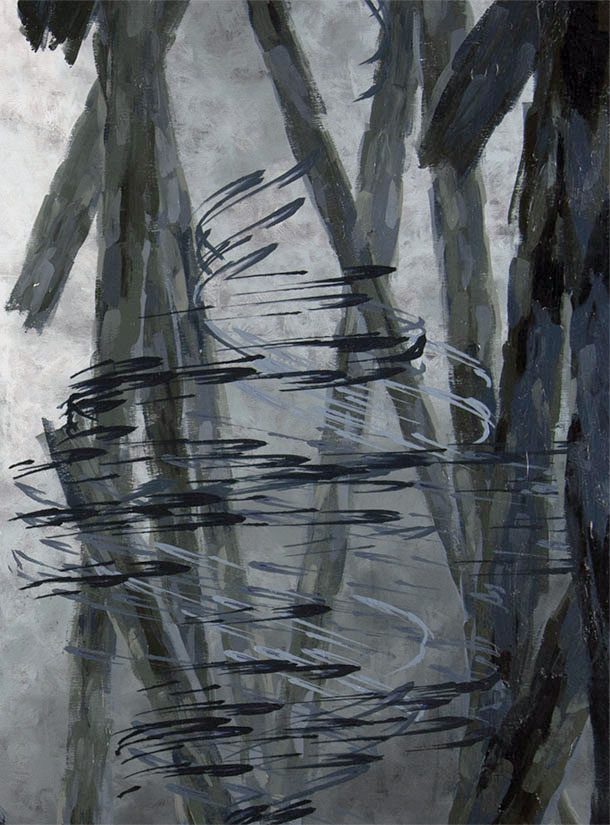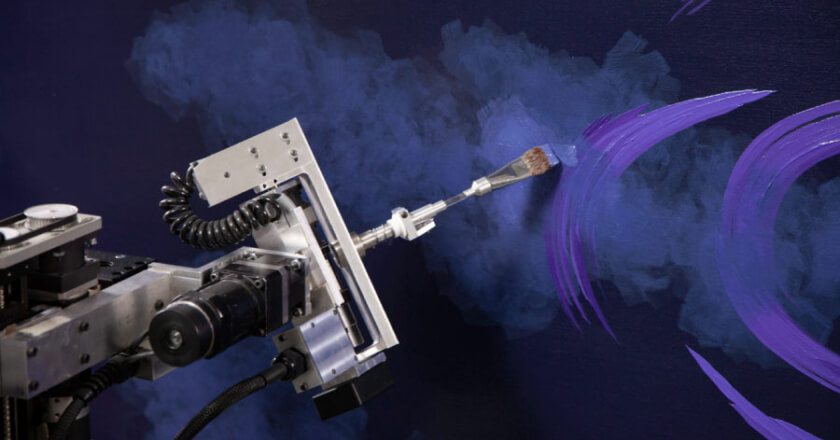Get Inspired
Build the life you love. Learn more about fusioneering:

Posted on January 17, 2022 in Art History
A chaotic wind sweeping through a dark forest of wreckage, the distance shrouded in haze: this is what the painting, Swirling Timbers of Chaos, appears to be… but who would have guessed that such a moody work had its origins in a children’s game, clay, complex mathematics, and — of all things — ants. Only from the mind of Paul Kirby and the hand of Dulcinea.
When Paul Kirby thought about what Dulcinea, his painting robot, should produce next, he was struck by the draw of creating something darker and edgier than anything Dulcinea had made before. An intense experience through an environment of gloom and foreboding. Paul’s mind caught on the notion of a swirl of energy moving through a forest arranged like a child’s pickup sticks, and immediately he ran with the idea. But how to infuse the visual structure with the correct tone? How does one make a pile of pickup sticks somber and mysterious? Paul thought to emulate one of the great master writers of the late 19th and early 20th Centuries: Sherlock Holmes creator, Sir Arthur Conan Doyle. Conceptual images and art based around the major set piece of Doyle’s Sherlock story, The Hound of the Baskervilles (the dark and terrifying moors surrounding Baskerville Hall) were compiled for use as reference materials in regards to tone, atmosphere, color, and lighting. A scale model was made with clay and balsa wood sticks to further test and three-dimensionally develop the concept.
Of course, it wouldn’t be a Paul Kirby & Dulcinea work without copious amounts of computation and math. First came the simulation of the “trees”… as well as a pleasant surprise. The artificial intelligence program parameters for seeding the timbers in the three-dimensional virtual world inadvertently did not include the requirement that the timbers be rooted to the ground — thus creating a rendering where jagged, dark staves hung in mid air. The accidental rendering actually served to be a blessing, amplifying the ominous and otherworldly qualities Paul sought in the piece.
For the tornado-like swirl at the painting’s heart, Paul wanted something complex and captivating — three-dimensional helical splines inside a cubic simulation, to be precise. But how to get the most energy and flow out of the structure? The answer was ants. Not real ants, but rather AI-simulated ant colonies with controllable variables and parameters.
Using the wandering and searching movements of virtual ants to create brushstroke maps was actually a technique that Paul had become rather fond of employing, with the ants being first used in the creation of Orange Painting. Prior ant usage had the simulated insects traveling and congregating on a two-dimensional plane.
Now, however, Paul wanted to elevate his use of three-dimensional perspective across Dulcinea’s works, and that meant bringing the ants into the third dimension as well. Paul dropped ant-attracting virtual bread crumbs along the spline lines of the helix swirl, gave a colony of 10,000 ants the ability to move in three dimensions without traditional gravitational restrictions, and then set the ants loose in the virtual forest and allowed them to do what they pleased. Ants that found crumbs dropped pebble markers and left pheromones for other ants. At the end of the simulation, the pebble markers were converted to a brushstroke map so Dulcinea could capture in paint the swirling, living motion of the ants’ journey.
Paul had almost all the pieces needed to create his Timbers painting. From complex computational systems and clay renderings, Paul did all he could to create a real sense of dimensionality and depth in his storm-swept forest. Much of what Paul had done in conceptualizing the painting had been rather avant-garde, but he would have been a fool if he’d ignored the great classical methods, too. Luckily, with fusioneering, no such choice needed to be made. To really sell the depth of the space in the painted world, Paul had Dulcinea employ a mainstay painting mode of the Renaissance, and a favorite technique of Da Vinci: sfumato. Sfumato is a painting technique that focuses on the softening of transitional areas between colors in order to mimic the out-of-focus planes that the human eye perceives in relation to where it is looking. This gentle blending of colors creates the realistic blur of trunks and haze that allows our minds to pass through the fourth wall of the canvas and perceive Timbers for the fully three-dimensional world that it technically isn’t.
Swirling Timbers of Chaos was an idea, a mathematical concept, a clay model, a complex simulation filled with virtual ants, and a brushstroke map inside a robot’s brain all before it was a canvas painting. That’s so many distinctly unique things – so many individual iterations of something that was at birth entirely intangible, but now is a physical object hanging on a wall. When you look at the finished painting, you do indeed embark on a journey into that wonderfully realized world, but what you see is not the journey that Paul went on to produce the piece. The truth is, to make a journey for someone else, it takes a journey of your own.
Can’t wait to see what Paul will be cooking up next? Join our mailing list to track every exciting development at the Kirby Foundation!
Are you interested in hearing the complete story of Paul and Dulcinea? Watch the video (nominated for Best Short Film at the 2021 Vail and Portland Film Festivals) for more info.
Want to be the first to know about every exciting new project at the Kirby Foundation?
Join Our Mailing ListBuild the life you love. Learn more about fusioneering:
Why pick which passion you should follow? Fusioneering allows you to cultivate many interests into something innovative and revolutionary.

Meet Paul and explore how blending your interests can empower you to follow your enthusiasm and bring your passions to life.